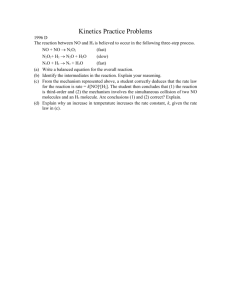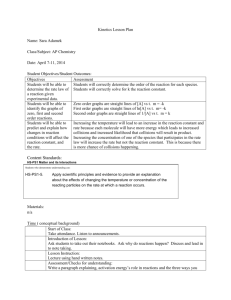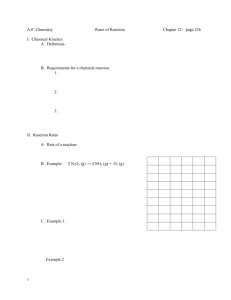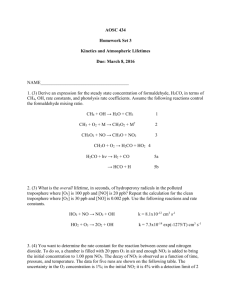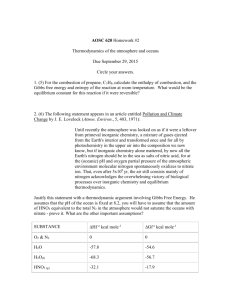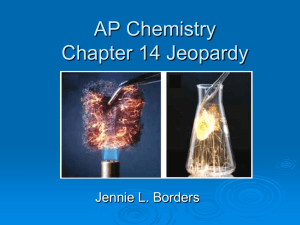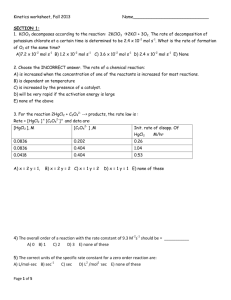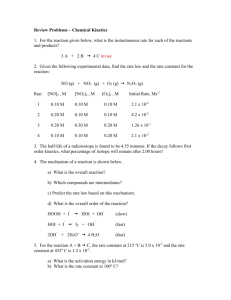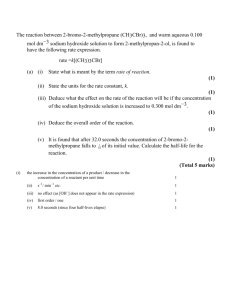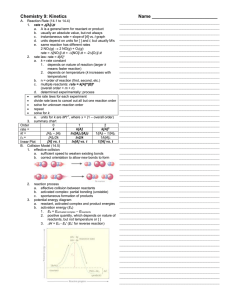AP Chemistry Unit 6- Homework Problems Kinetics Collision Theory
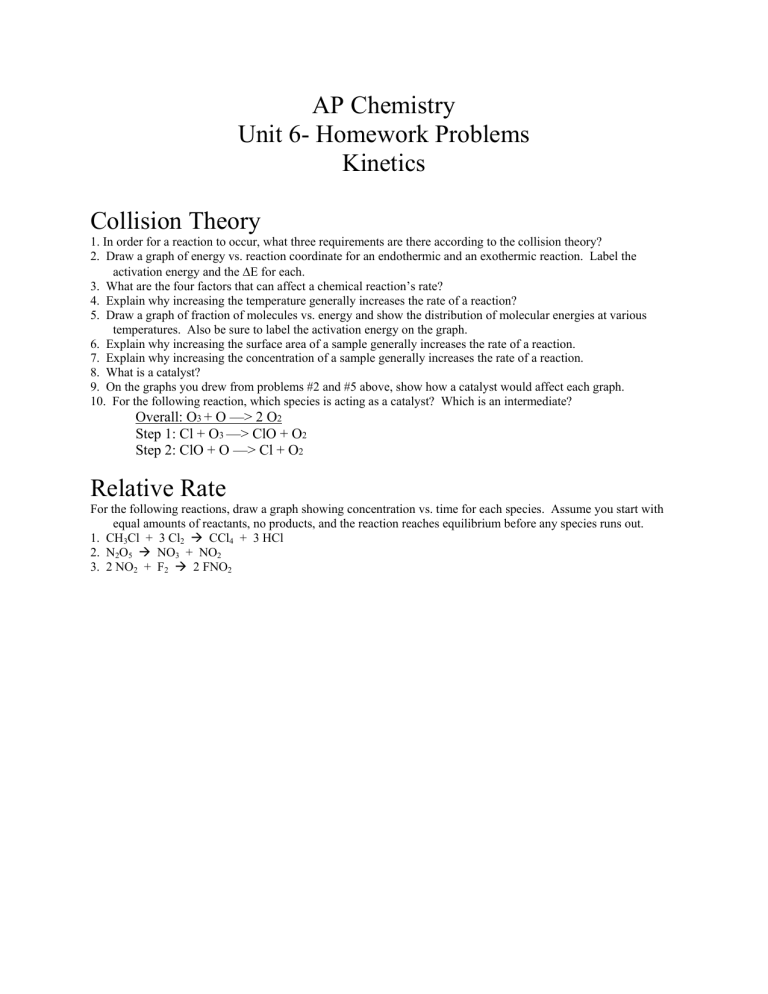
AP Chemistry
Unit 6- Homework Problems
Kinetics
Collision Theory
1. In order for a reaction to occur, what three requirements are there according to the collision theory?
2. Draw a graph of energy vs. reaction coordinate for an endothermic and an exothermic reaction. Label the activation energy and the
E for each.
3. What are the four factors that can affect a chemical reaction’s rate?
4. Explain why increasing the temperature generally increases the rate of a reaction?
5. Draw a graph of fraction of molecules vs. energy and show the distribution of molecular energies at various temperatures. Also be sure to label the activation energy on the graph.
6. Explain why increasing the surface area of a sample generally increases the rate of a reaction.
7. Explain why increasing the concentration of a sample generally increases the rate of a reaction.
8. What is a catalyst?
9. On the graphs you drew from problems #2 and #5 above, show how a catalyst would affect each graph.
10. For the following reaction, which species is acting as a catalyst? Which is an intermediate?
Overall: O
3
+ O —> 2 O
2
Step 1: Cl + O
3
—> ClO + O
2
Step 2: ClO + O —> Cl + O
2
Relative Rate
For the following reactions, draw a graph showing concentration vs. time for each species. Assume you start with equal amounts of reactants, no products, and the reaction reaches equilibrium before any species runs out.
1. CH
3
Cl + 3 Cl
2
CCl
4
+ 3 HCl
2. N
2
O
5
3. 2 NO
NO
2
+ F
2
3
+ NO
2
2 FNO
2
Rate Equations
1. Consider the following data for the reaction:
[A] (M) Initial Rate of Production of B (M/s)
A B
0.100
0.200
0.300
0.053
0.210
0.473 a) What is the order with respect to A? b) Write the rate law. c) What is the value of k (include units)? d) What would the initial rate be if [A] = 0.05 M?
2. Consider the following data for the reaction: A
B
[A] (M) Initial Rate of Production of B (M/s)
0.15 0.008
0.30
0.60
0.016
0.032 a) What is the order with respect to A? b) Write the rate law. c) What is the value of k (include units)? d) What would the initial rate be if [A] = 0.75 M?
3. Consider the following data for the reaction: 2 NO
2
+ F
2
2 FNO
2
[NO
2
] (M)
0.100
[F
2
] (M)
0.100
Initial Rate of Loss of NO
0.026
2
(M/s)
0.200
0.200
0.400
0.100
0.200
0.400
0.051
0.103
0.411 a) What is the order with respect to NO
2
? What is the order with respect to F
2
? What is the overall order? b) Write the rate law. c) What is the value of k (include units)? d) What would the initial rate be if [NO
2
] = 0.050 M and [F
2
] = 0.075 M? e) For each line of the data table above, calculate the initial rate of loss of F
2
.
Mechanisms
1. For the following reaction:
Step 1: AB + AB AB
2
AB + C
+ A
Step 2: AB
2
+ C
AB + BC
A + BC, the following mechanism is proposed: slow fast a. Write the rate law based upon this information. b. Which species is an intermediate in the above mechanism?
2. For the following reaction:
Step 1: NO
Step 2: NO
2
2
+ Cl
2
2 NO
ClNO
+ Cl ClNO
2
2
+ Cl
2
+ Cl
2
2 ClNO
2
, the following mechanism is proposed: slow fast a. Write the rate law based upon this information. b. Which species is an intermediate in the above mechanism?
3. For the following reaction: X + Y XY, the following mechanism is proposed:
Step 1: 2 X
Step 2: X
2
X
2
+ Y XY + X fast slow a. Write the rate law based upon this information. b. Which species is an intermediate in the above mechanism?
4. For the following reaction:
Step 1: I
2
2 I
Step 2: H
2
+ 2 I
2 HI
H
2
+ I
2
2 HI, the following mechanism is proposed: fast slow a. Write the rate law based upon this information. b. Which species is an intermediate in the above mechanism?
5. Why can’t you tell what the rate equation is just from looking at the overall reaction?
Integrated Rate Equations
1. The following is data for the reaction: AB A + B
Time (sec) [AB] (M)
0 0.95
50
100
0.459
0.302
150
200
250
300
0.225
0.180
0.149
0.128 a. What is the order of the reactant AB? b. Write the rate law. c. What is the value for k? d. What would the concentration be at 1000 seconds? e. What is the half-life of the reaction?
2. The following is data for the reaction: N
2
O
5
NO
3
+ NO
2
Time (sec) [N
2
O
5
] (M)
0 1.00
25
50
0.822
0.677
75
100
125
150
0.557
0.458
0.377
0.310 a. What is the order of the reactant N
2
O
5
? b. Write the rate law. c. What is the value for k? d. What would the concentration be at 500 seconds? e. What is the half-life of the reaction?
3. The following is data for the reaction: C
4
H
8
2 C
2
H
4
Time (sec) [C
4
H
8
] (M)
0 1.00
10
20
0.894
0.799
30
40
50
60
0.714
0.638
0.571
0.510 a. What is the order of the reactant C
4
H
8
? b. Write the rate law. c. What is the value for k? d. What would the concentration be at 100 seconds? e. What is the half-life of the reaction?
4. The following is data for the reaction: A
B
Time (sec) [C
4
H
8
] (M)
0
25
1.00
0.914
50
75
100
125
150
0.829
0.744
0.659
0.573
0.488 a. What is the order of the reactant A? b. Write the rate law. c. What is the value for k? d. What would the concentration be at 100 seconds? e. What is the half-life of the reaction?
Arrhenius Equation
1. The following is data for the reaction: N
2
O
5
2 NO
2
+ ½ O
2
T (K)
338
328
318
308
298
273
K
4.87x10
-3
1.50 x10
-3
4.98 x10
-4
1.35 x10
-4
3.46 x10
-5
7.87 x10
-7
Calculate the activation energy of this reaction.
2. A + B
C + D
T (K)
298
308
318
K
0.0409
0.0818
0.157
Calculate the activation energy of this reaction.
Combination Problems
1. For the equations:
2 A + B C + D
Experiment Initial [A]
1
2
3
4 a) Determine the order of the reaction with respect to A and to B. Justify your answer. b) Write the rate law for the reaction. Calculate the value of the rate constant, specifying units. c) Determine the initial rate of change of [A] in experiment #3 d. Determine the initial value of [B] in Experiment #4 e) Identify which of the following mechanisms is consistent with the rate law developed in part b. Justify your choice. i) A + B
C + M Fast
M + A D Slow ii) B
M Fast equilibrium
M + A
C + X Slow
A + X
Fast iii) A + B
M Fast equilibrium
M + A
C + X Slow
X
D Fast
2. The first-order decomposition of a colored species, X, into a colorless product is monitored with a spectrophotometer. The following table shows the results:
[X] M
????
4.00x10
-5
3.00x10
-5
1.50x10
-5
0.25
0.75
1.50
1.75
Initial [B] Initial Rate of formation of C (M/min)
0.75 4.2x10
-4
0.75
1.50
???
1.3x10
-3
5.3x10
-3
8.0x10
-3
Absorbance
0.600
0.200
0.150
0.075
Time (min)
0.0
35.0
44.2
??? a) Calculate the initial concentration of the colored species. b) Calculate the rate constant for the 1 st
-order reaction using the values given for concentration and time. Include units. c) Calculate the number of minutes it takes for the absorbance to drop from 0.600 to
0.075 d) Calculate the half-life of the reaction. Include units. e) Label the vertical axis of the following graph which will be able to calculate E a
.
???
1/T
3. For the equation:
2 H
2
O
2
(aq)
2 H
2
O (l) + O
2
(g) a. An aqueous solution of H
2
O
2
that is 6% H
2
O
2
by mass has a density of 1.03 g/mL. i) Calculate the original moles of H
2
O
2
in a 125 mL sample of the solution ii) The number of moles of O
2
that are made when all of the sample from a reacts b. The graphs below show results from a study of the decomposition of H
2
O
2 i) Write the rate law for the reaction. Justify your answer ii) Determine the half-life of the reaction. iii) Calculate the value of the rate constant, k. Include units. iv) Determine [H
2
O
2
] after 2000 minutes elapse from the time it began
4. For the reaction:
X
2 Y + Z
In a certain experiment, the reaction took place in a 5.00 L flask at 428 K. Data from the experiment were used to produce the table below which is then plotted in the graphs that follow:
Time (min) [X] mol/L Ln [X] 1/[X] L/mol
0 0.00633 -5.062 158
10
20
0.00520
0.00427
-5.259
-5.456
192
234
30
50
70
100
0.00349 -5.658
0.00236 -6.049
0.00160 -6.438
0.000900 -7.013
287
424
625
1,110 a. How many moles of X were initially in the flask? b. How many molecules of Y were produced in the first 20. minutes of the rxn c. What is the order of this reaction with respect to X? Justify your answer. d. Write the rate law for the reaction. e. Calculate the specific rate constant for this reaction. Specify units. f. Calculate the concentration of X in the flask after a total of 150 min of rxn.
5. For the reactions:
Step I:
Step II:
O
3
+ Cl
O
2
ClO + O
+ ClO
Cl + O
2 a. Write a balanced equation for the overall reaction represented by Step I and Step II b. Clearly identify the catalyst in the mechanism above. Justify. c. Clearly identify the intermediate in the mechanism above. Justify. d. If the rate law for the above reaction is rate = k [O
3
][Cl], determine: i) The overall order of the reaction ii) Appropriate units for the rate constant, k iii) The rate-determining step of the reaction, along with justification of your answer.
6.
